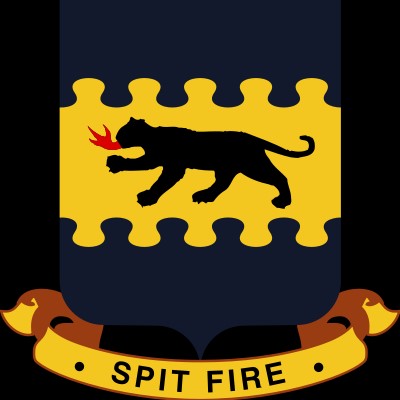Republic P-47D Thunderbolt
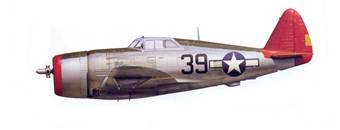
P-47D (serial unknown) of 1st Lt. Gwynne Peirson, Ramitelli, 302nd FS, Italy, June 1944
Development of the P-47
By the end of World
War II the Republic P-47 Thunderbolt would be known as the heaviest
and most expensive fighter produced to operate with a single engine.
It beca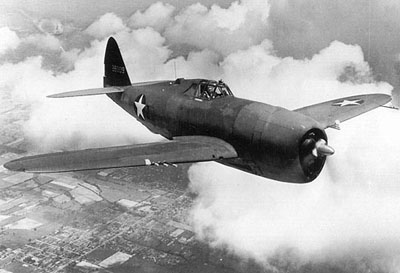 me
affectionately known as the "Jug" to its pilots and mechanics. This
big fighter had many pilot amenities such a roomy cockpit with a
seat quite like a lounge chair described by many of its pilots.
Although not as maneuverable as its contemporaries such as the
Spitfire, ME-109 and Zero.
me
affectionately known as the "Jug" to its pilots and mechanics. This
big fighter had many pilot amenities such a roomy cockpit with a
seat quite like a lounge chair described by many of its pilots.
Although not as maneuverable as its contemporaries such as the
Spitfire, ME-109 and Zero.
The Thunderbolt was a very fast aircraft. It also dove faster than any other plane of the war. The prototype first flew on 6 May 1941. Before the prototype was destroyed in a crash the Thunderbolt logged an astounding 412 MPH in level flight at 25,000 ft. The USAAC ordered 171 copies of the initial offering of the "Jug".
The armament of the Thunderbolt made it a p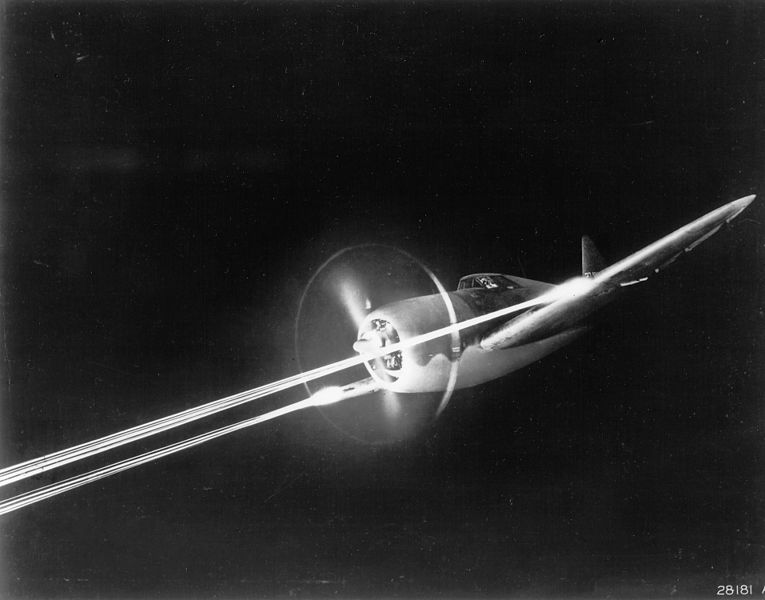 otent
air to air and air to ground weapon system. Its eight 50 Caliber
Browning machine guns would make short work of just about any enemy
aircraft that showed up in front of it. As newer and more powerful
versions of the Thunderbolt were introduced to USAAF pilots, the
"Jug" proved to be a capable fighter, but an even better ground
attack aircraft. The Thunderbolt would return many American pilots
to their home bases with immeasurable damage.
otent
air to air and air to ground weapon system. Its eight 50 Caliber
Browning machine guns would make short work of just about any enemy
aircraft that showed up in front of it. As newer and more powerful
versions of the Thunderbolt were introduced to USAAF pilots, the
"Jug" proved to be a capable fighter, but an even better ground
attack aircraft. The Thunderbolt would return many American pilots
to their home bases with immeasurable damage.
There is one particular account where a 56th
FG pilot returned to base in his Thunder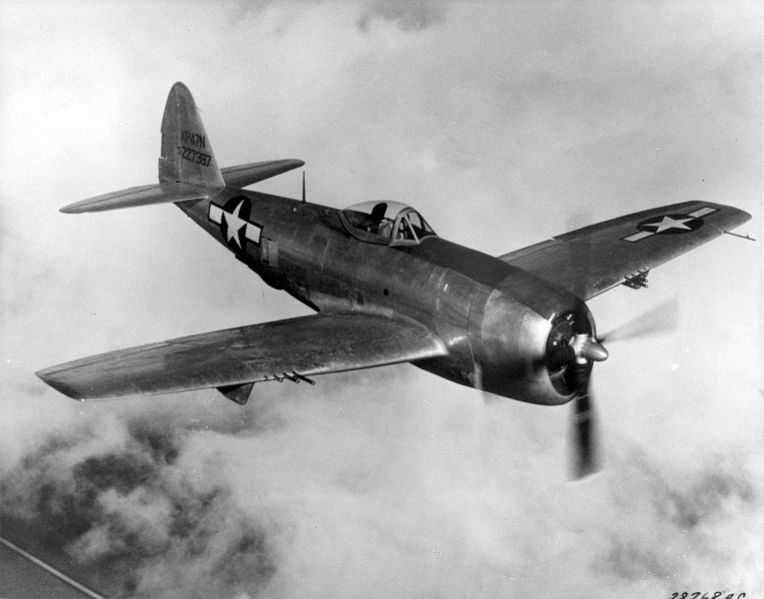 bolt
with two bullets in his leg, 20 or more 20mm cannon shell holes in
the airframe, and the pilot stated that he stopped counting holes in
the plane from that mission when he got to one hundred. The pilot
lived to fight another day. But that Thunderbolt was scrapped for
salvage as too much damage rendered the aircraft not airworthy. For
what this aircraft lacked in maneuverability and rate of climb. It
clearly made up for in toughness and firepower.
bolt
with two bullets in his leg, 20 or more 20mm cannon shell holes in
the airframe, and the pilot stated that he stopped counting holes in
the plane from that mission when he got to one hundred. The pilot
lived to fight another day. But that Thunderbolt was scrapped for
salvage as too much damage rendered the aircraft not airworthy. For
what this aircraft lacked in maneuverability and rate of climb. It
clearly made up for in toughness and firepower.
By wars end the Thunderbolt had seen numerous upgrades and amendments. It had fought in every theater of operation and can most certainly lay claim to the best ground attack aircraft of the war. In fact there was one American fighter group to end the war in the P-47 Thunderbolt rather than switch to the P-51 Mustang; the 56th Fighter Group. The P-47 had performed so well at destroying German aircraft that it actually destroyed more aircraft than the P-51 Mustangs did in the same theater. Another dubious honor the Thunderbolt walks away from World War II with is the fastest production aircraft of the war in level flight.
Although the P-51 Mustang notably receives the honor as the weapon system that brought the Luftwaffe to its end, Thunderbolt pilots would clearly state that the "Jug" was there first, making that event possible.
The 332nd FG Transitions to the Thunderbolts.
After an anguishing start to their aerial
combat careers, it was time for the 332nd Fighter Group
to make the transition to the Republic P-47 Thunderbolt. On 25 April
1944 the Fighter Group received its first six P-47s. Although these
aircraft were handed down from use by the 325th Fighter
Group, they were a welcome change from flying the P-39s. The Fighter
Group pilots enjoyed the P-47. It was big, rugged and had plenty of
guns. Although the 332nd had
 begun
to receive fighters with better performance the groups reputation
was initially marred by a number of accidents causing pilot deaths
and lose of aircraft.
begun
to receive fighters with better performance the groups reputation
was initially marred by a number of accidents causing pilot deaths
and lose of aircraft.
On one particular mission 2nd Lt. Lloyd Hathcock landed and surrendered a fully functional example of the P-47 Thunderbolt to the Luftwaffe. While recovering to Capodichino Lt. Hathcock made a thirty-five mile navigational mistake in the wrong direction. When he landed the Thunderbolt safely at an airfield just outside of the city of Rome in German held territory.
He was quite surprised as the pale faced German ground crews took him captive and interned his aircraft. The aircraft was then transferred to the infamous Zirkus Rosarius who's job it was to familiarize Luftwaffe pilots with Allied aircraft. The aircraft was kept in flying condition until the last weeks of the war. This aircraft was recaptured by allied ground forces later in the war.
On 8 June 1944 32 P-47Ds from the 332nd FG went aloft on their first fighter escort mission, lead by Col. Benjamin O Davis Jr., it would not be their last. Col. Davis stressed in the mission briefing that the bomber groups needed effective escort. Otherwise meaning that the 332nd would be escorting the bombers from door step to door step. Most fighter groups of the time would leave the bomber group immediately following the ordnance drop to search out targets of opportunity. The 332nd FG would be detailing flight elements to escort stragglers back to allied bases where they could land safely.
On this very same day the 332nd FG scored five enemy aircraft in one day with their P-47 Thunderbolts. These five kills would be the only victories they would experience in the P-47. On yet another mission to attack a German troop concentration pilots of the 301st and 302nd Fighter Squadrons located what is described as a enemy destroyer out-chopping from Trieste Harbor in north east Italy. The ship is actually an Italian torpedo boat converted to a mine layer taken over by the Kreigs Marine. The pilots wasted no time and swooped in for the attack. The devastating firepower of the P-47s eight 50 caliber machine guns caused the munitions aboard the ship to violently explode sending the ship to the bottom of Trieste harbor. The two pilots that spotted and initiated the attack were awarded the DFC. Although the P-47 added power and performance to the 332nd operations, the last mission flown by the group in the P-47 would be on 30 June 1944. It was time for the 332nd to make another transition.
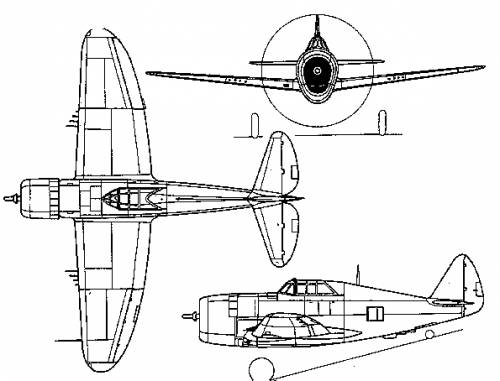
Republic P-47D Thunderbolt Specifications
| Power Plant: | Pratt & Whitney R-2800-59 Radial Air Cooled |
| Horsepower: | 2,535 HP |
| Maximum Speed: | 433 MPH at 33,000 ft. |
| Rate of Climb: | 3,120ft/min. |
| Maximum Range: | 800 miles in combat configuration |
| Service Ceiling: | 43,000 ft. |
| A/C Weight: | 10,000 lbs. Empty weight, 17,500 lbs. Loaded weight |
| Wing Span: | 40 ft. 9 in. |
| Fuselage Length: | 36 ft. 1 in. |
| Height: | 14 ft. 8 in. |
| Wing Area: | 300 sq. ft. |
| Armament: | Eight 50 Cal. MG 2,500 lbs. of bombs, 10 X 5 in. rockets |
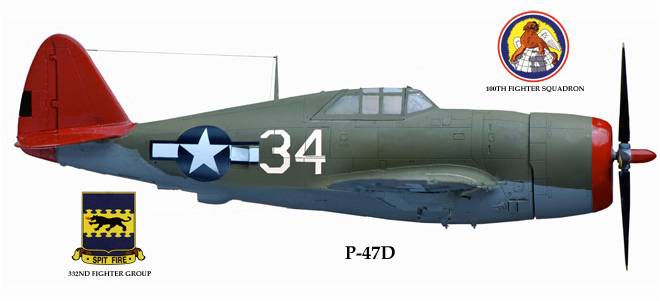 |
|

